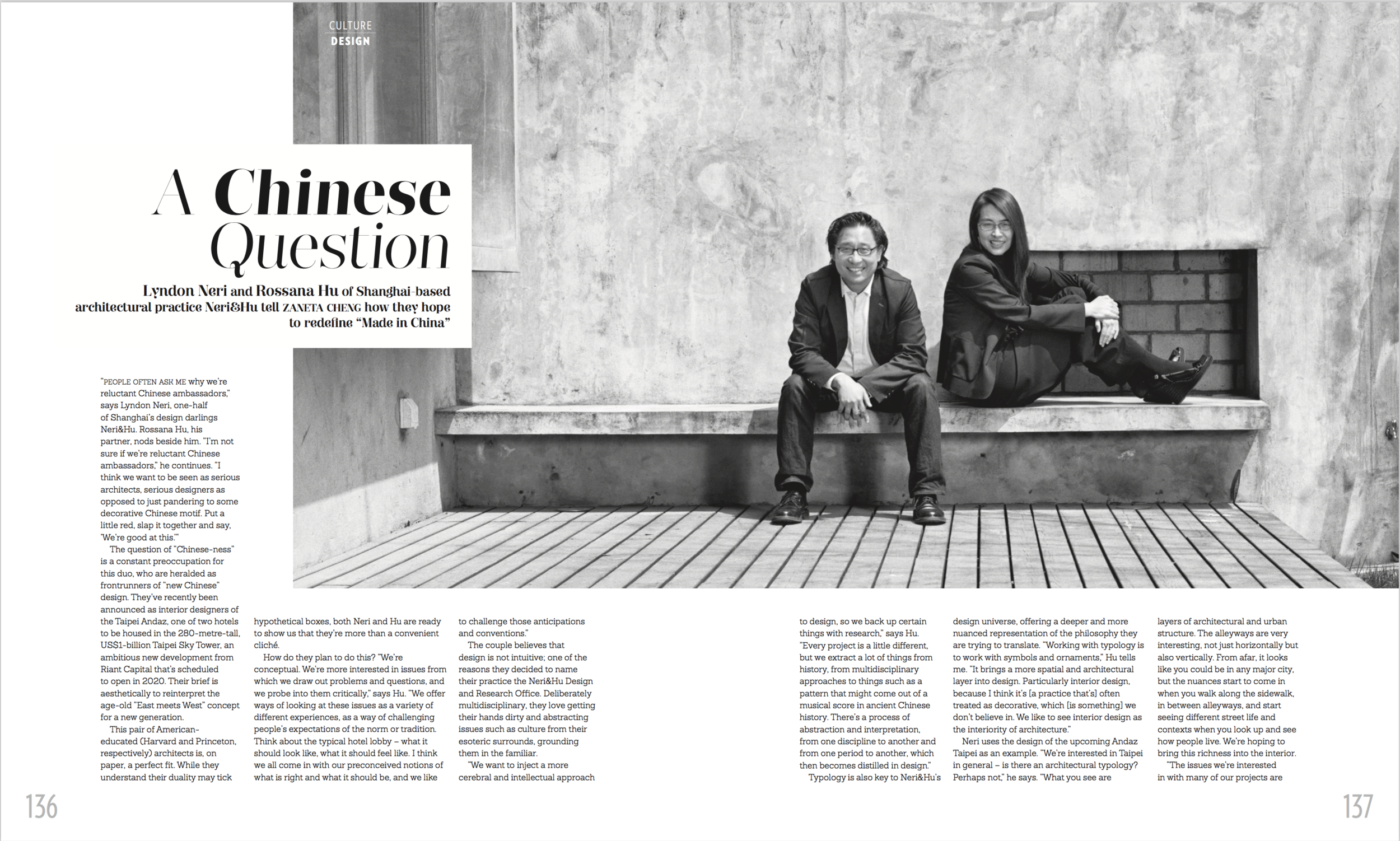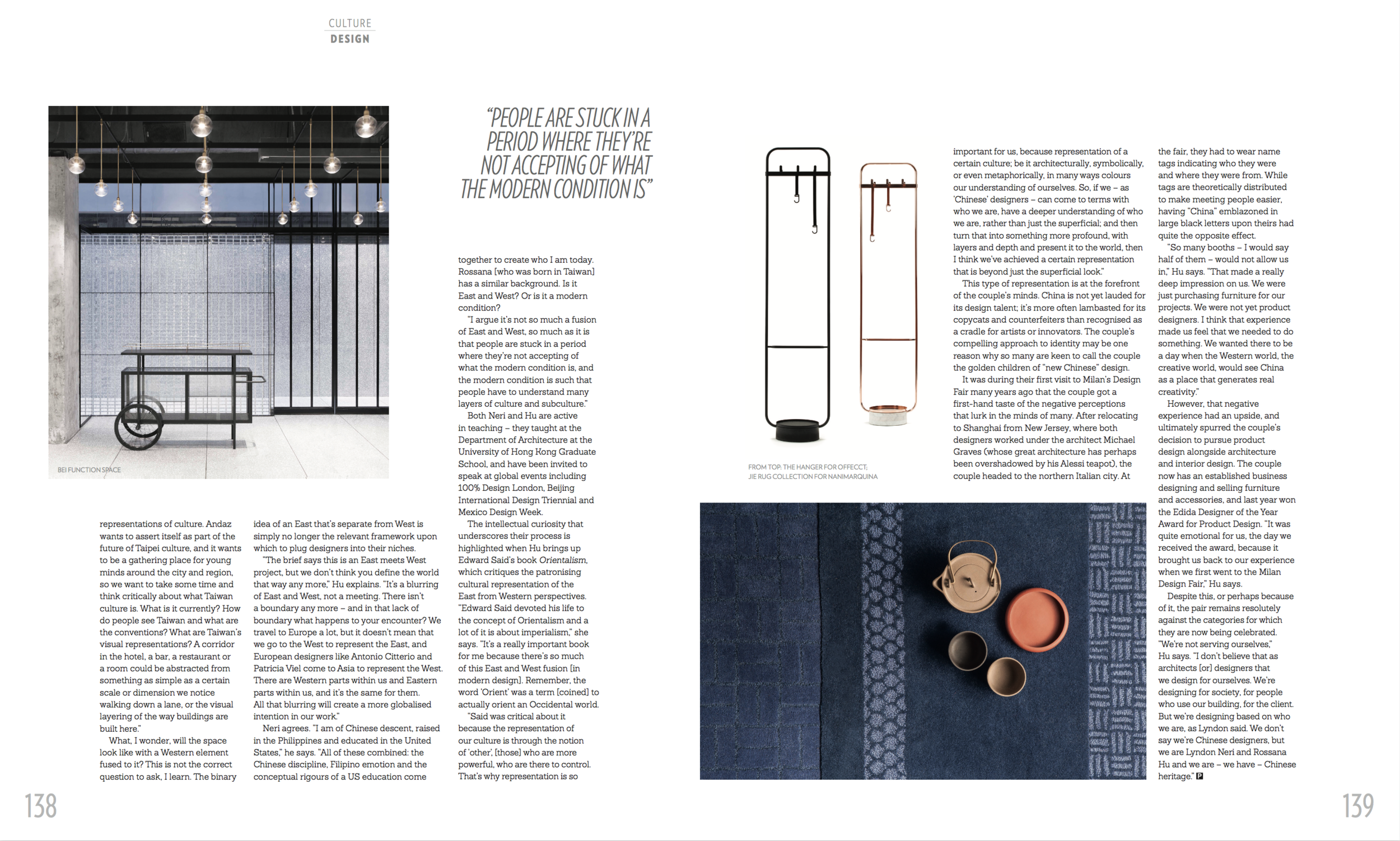Neri & Hu (A Chinese Question) | Prestige Hong Kong (Mar 18)
Lyndon Neri and Rossana Hu of Shanghai-based architectural practice Neri&Hu tell zaneta cheng how they hope to redefine “Made in China”
“People often ask me why we’re reluctant Chinese ambassadors,” says Lyndon Neri, one-half of Shanghai’s design darlings Neri&Hu. Rossana Hu, his partner, nods beside him. “I’m not sure if we’re reluctant Chinese ambassadors,” he continues. “I think we want to be seen as serious architects, serious designers as opposed to just pandering to some decorative Chinese motif. Put a little red, slap it together and say, ‘We’re good at this.’”
The question of “Chinese-ness” is a constant preoccupation for this duo, who are heralded as frontrunners of “new Chinese” design. They’ve recently been announced as interior designers of the Taipei Andaz, one of two hotels to be housed in the 280-metre-tall, US$1-billion Taipei Sky Tower, an ambitious new development from Riant Capital that’s scheduled to open in 2020. Their brief is aesthetically to reinterpret the
age-old “East meets West” concept for a new generation.
This pair of American-educated (Harvard and Princeton, respectively) architects is, on paper, a perfect fit. While they understand their duality may tick hypothetical boxes, both Neri and Hu are ready to show us that they’re more than a convenient cliché.
How do they plan to do this? “We’re conceptual. We’re more interested in issues from which we draw out problems and questions, and we probe into them critically,” says Hu. “We offer ways of looking at these issues as a variety of different experiences, as a way of challenging people’s expectations of the norm or tradition. Think about the typical hotel lobby – what it should look like, what it should feel like. I think we all come in with our preconceived notions of what is right and what it should be, and we like to challenge those anticipations and conventions.”
The couple believes that design is not intuitive; one of the reasons they decided to name their practice the Neri&Hu Design and Research Office. Deliberately multidisciplinary, they love getting their hands dirty and abstracting issues such as culture from their esoteric surrounds, grounding them in the familiar.
“We want to inject a more cerebral and intellectual approach to design, so we back up certain things with research,” says Hu. “Every project is a little different, but we extract a lot of things from history, from multidisciplinary approaches to things such as a pattern that might come out of a musical score in ancient Chinese history. There’s a process of abstraction and interpretation, from one discipline to another and from one period to another, which then becomes distilled in design.”
Typology is also key to Neri&Hu’s design universe, offering a deeper and more nuanced representation of the philosophy they are trying to translate. “Working with typology is to work with symbols and ornaments,” Hu tells me. “It brings a more spatial and architectural layer into design. Particularly interior design, because I think it’s [a practice that’s] often treated as decorative, which [is something] we don’t believe in. We like to see interior design as the interiority of architecture.”
Neri uses the design of the upcoming Andaz Taipei as an example. “We’re interested in Taipei in general – is there an architectural typology? Perhaps not,” he says. “What you see are layers of architectural and urban structure. The alleyways are very interesting, not just horizontally but also vertically. From afar, it looks like you could be in any major city, but the nuances start to come in when you walk along the sidewalk, in between alleyways, and start seeing different street life and contexts when you look up and see how people live. We’re hoping to bring this richness into the interior.
“The issues we’re interested in with many of our projects are representations of culture. Andaz wants to assert itself as part of the future of Taipei culture, and it wants to be a gathering place for young minds around the city and region, so we want to take some time and think critically about what Taiwan culture is. What is it currently? How do people see Taiwan and what are the conventions? What are Taiwan’s visual representations? A corridor in the hotel, a bar, a restaurant or a room could be abstracted from something as simple as a certain scale or dimension we notice walking down a lane, or the visual layering of the way buildings are built here.”
What, I wonder, will the space look like with a Western element fused to it? This is not the correct question to ask, I learn. The binary idea of an East that’s separate from West is simply no longer the relevant framework upon which to plug designers into their niches.
“The brief says this is an East meets West project, but we don’t think you define the world that way any more,” Hu explains. “It’s a blurring of East and West, not a meeting. There isn’t a boundary any more – and in that lack of boundary what happens to your encounter? We travel to Europe a lot, but it doesn’t mean that we go to the West to represent the East, and European designers like Antonio Citterio and Patricia Viel come to Asia to represent the West. There are Western parts within us and Eastern parts within us, and it’s the same for them. All that blurring will create a more globalised intention in our work.”
Neri agrees. “I am of Chinese descent, raised in the Philippines and educated in the United States,” he says. “All of these combined: the Chinese discipline, Filipino emotion and the conceptual rigours of a US education come together to create who I am today. Rossana [who was born in Taiwan] has a similar background. Is it East and West? Or is it a modern condition?
“I argue it’s not so much a fusion of East and West, so much as it is that people are stuck in a period where they’re not accepting of what the modern condition is, and the modern condition is such that people have to understand many layers of culture and subculture.”
Both Neri and Hu are active in teaching – they taught at the Department of Architecture at the University of Hong Kong Graduate School, and have been invited to speak at global events including 100% Design London, Beijing International Design Triennial and Mexico Design Week.
The intellectual curiosity that underscores their process is highlighted when Hu brings up Edward Said’s book Orientalism, which critiques the patronising cultural representation of the East from Western perspectives. “Edward Said devoted his life to the concept of Orientalism and a lot of it is about imperialism,” she says. “It’s a really important book for me because there’s so much of this East and West fusion [in modern design]. Remember, the word ‘Orient’ was a term [coined] to actually orient an Occidental world.
“Said was critical about it because the representation of our culture is through the notion of ‘other’, [those] who are more powerful, who are there to control. That’s why representation is so important for us, because representation of a certain culture; be it architecturally, symbolically, or even metaphorically, in many ways colours our understanding of ourselves. So, if we – as ‘Chinese’ designers – can come to terms with who we are, have a deeper understanding of who we are, rather than just the superficial; and then turn that into something more profound, with layers and depth and present it to the world, then I think we’ve achieved a certain representation that is beyond just the superficial look.”
This type of representation is at the forefront of the couple’s minds. China is not yet lauded for its design talent; it’s more often lambasted for its copycats and counterfeiters than recognised as a cradle for artists or innovators. The couple’s compelling approach to identity may be one reason why so many are keen to call the couple the golden children of “new Chinese” design.
It was during their first visit to Milan’s Design Fair many years ago that the couple got a first-hand taste of the negative perceptions that lurk in the minds of many. After relocating to Shanghai from New Jersey, where both designers worked under the architect Michael Graves (whose great architecture has perhaps been overshadowed by his Alessi teapot), the couple headed to the northern Italian city. At the fair, they had to wear name tags indicating who they were and where they were from. While tags are theoretically distributed to make meeting people easier, having “China” emblazoned in large black letters upon theirs had quite the opposite effect.
“So many booths – I would say half of them – would not allow us in,” Hu says. “That made a really deep impression on us. We were just purchasing furniture for our projects. We were not yet product designers. I think that experience made us feel that we needed to do something. We wanted there to be a day when the Western world, the creative world, would see China as a place that generates real creativity.”
However, that negative experience had an upside, and ultimately spurred the couple’s decision to pursue product design alongside architecture and interior design. The couple now has an established business designing and selling furniture and accessories, and last year won the Edida Designer of the Year Award for Product Design. “It was quite emotional for us, the day we received the award, because it brought us back to our experience when we first went to the Milan Design Fair,” Hu says.
Despite this, or perhaps because of it, the pair remains resolutely against the categories for which they are now being celebrated. “We’re not serving ourselves,” Hu says. “I don’t believe that as architects [or] designers that we design for ourselves. We’re designing for society, for people who use our building, for the client. But we’re designing based on who we are, as Lyndon said. We don’t say we’re Chinese designers, but we are Lyndon Neri and Rossana Hu and we are – we have – Chinese heritage.”

